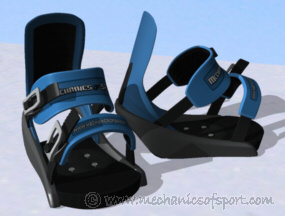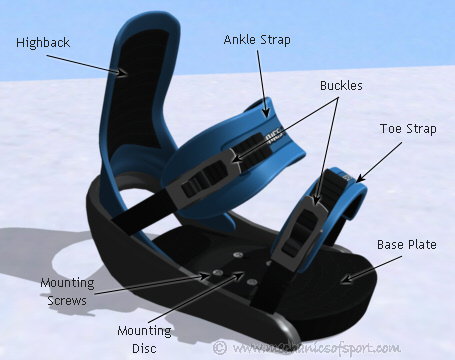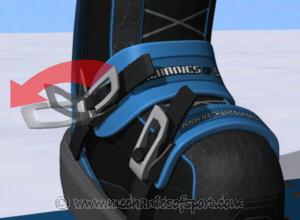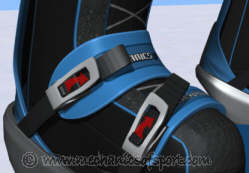Snowboard Bindings

Just like snowboards, there are several types of snowboard bindings out there. This page concentrates on strap-in bindings (the most common type) which have 2 straps with buckles to adjust their tightness, and an adjustable highback. Unlike skiing bindings, snowboard bindings will not release your foot if you have a bad crash. This does not really cause problems however, since both feet are bound together with the snowboard, and it is a lot harder to twist your legs, although it does make upper body injuries more common in snowboarding.
The bindings are normally attached to the snowboard with 4 screws, although there are types that only use 3 screws. On a snowboard there are several sets of holes for the bindings so that the rider can choose how far apart and how far along the board they want their bindings. Unlike ski bindings which would normally be put on in a shop and never taken off, snowboard bindings are normally put on by the snowboarder, and can often be taken off or loosened for storage or adjustment.
Parts of a Strap-in Snowboard Binding

Ankle Strap - The strap that goes around the ankle and holds the foot when you lean forwards onto the toes.
Toe Strap - The strap that goes over the toes, and holds the foot when leaning backwards onto the heals.
Highback - The back of the binding that supports the back of the leg, and transmits force to the heal edge when leaning backwards.
Buckles - The parts of the bindings that tighten and hold the straps in place.
Base Plate - The bottom of the binding that the rest of the binding is joined to, it acts as a shock absorber as well as holding the binding together.
Mounting Disc - The part of the binding that is screwed into the snowboard, it has a splined edge so that the binding can be mounted at different angles.
Mounting Screws - The screws that hold the binding onto the snowboard.
Tightening the Bindings

Firstly with your foot as far back in the binding as possible, push the plastic ladder strap into the end of the main strap with the buckle on it, until the ratchet clicks and the straps will not come apart. To tighten the strap, pull the large lever on the buckle back and away from the boot. Then let the lever spring back to position and repeat until the strap is tight enough. The straps should generally be quite tight so that the boot cannot move much in the binding, although not so tight that your circulation is starting to be cut off.
Releasing the Bindings

To release the binding simply push the release catch in the middle of the buckle forwards and pull the main strap away from the plastic ladder strap. The release catch lifts the ratchet off of the ridges on the ladder strap so that the straps can slide smoothly apart.
Other Types of Bindings
At present there are several other types of snowboard bindings that you can buy, instead of the strap-in bindings shown here. Pretty much all the other types of binding have one advantage over the normal binding, they are quicker to put on, but in making them quicker to put on they have to compromise in other areas. The 2 most common other types of binding are rear entry bindings, and step-in bindings.
- Rear Entry Bindings - Often referred to as Flow bindings. The ankle and toe straps are joined together, and do not tighten up while your foot is in the binding, instead the highback has a catch on it allowing it to come backwards so that your foot enters and exits from the rear of the binding. This setup has less adjustment, a different flex/feel to it, and is heavier that the normal style of binding. The system is popular with people who are looking for a quick and easy binding to put on, and don't mind the reduced adjustment and responsiveness, and the extra weight.
- Step-in Bindings - Where a special snowboard boot locks into a binding mechanism on the snowboard, some versions have a highback on the binding, some don't. Step-in bindings are the quickest and easiest bindings to put on and off, but they also have the least adjustability. The binding mechanism on the board can also get clogged up with snow, which can be hard to clear, but boarders who use step-in bindings generally choose the easy of use and constant feel of the bindings, over lack of adjustability and occasional clogging inconveniences. This style of bindings is dying out though, with seemingly no major manufacturers making them any more.
As with most things even though the less common types of bindings have their flaws, the better and more expensive the version of the bindings are the less the flaws will be noticed. New types of bindings are also emerging that try to combine the advantages of the step-in and rear entry systems, keeping the two normal straps and their adjustment, but with the quick rear entry option that Flow bindings have. These types of binding are still relatively new though, and only time will tell how popular they are in the long run.
Leashes
Using a leash is becoming less and less common, but back in snowboarding's infancy when snowboard bindings weren't so reliable, leashes were used to tie the front boot to the front binding so that the board could not come off or slide away. These days, as the only time most leashes connect the boot and binding is when the boot is already in the binding, there is no real use for them, and all they do is get in the way and make it harder to take your snowboard off.
On to the Snowboard Boots section.